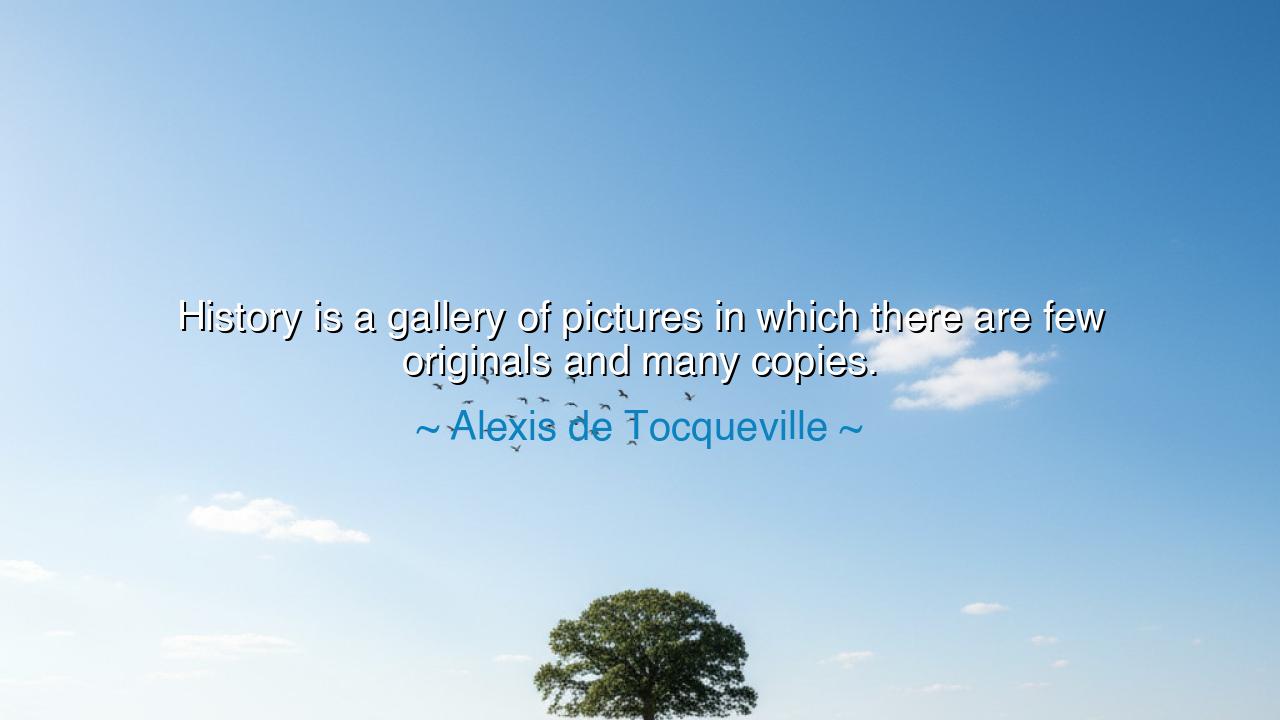
History is a gallery of pictures in which there are few originals






The French philosopher and historian Alexis de Tocqueville, whose keen eyes saw into the soul of nations, once wrote: “History is a gallery of pictures in which there are few originals and many copies.” These words, both elegant and piercing, carry the weight of centuries within them. For in them, Tocqueville unveils a truth about mankind that is both humbling and eternal — that through all the ages, though times and empires may change, the hearts and deeds of men repeat themselves. The gallery of history is vast, adorned with the portraits of kings, generals, thinkers, and revolutionaries — but if one looks closely, one finds that most are not new faces, but reflections of those who came before.
Tocqueville, who journeyed across America in the 19th century to understand the meaning of democracy, had studied deeply the movements of nations and the patterns of power. He saw how civilizations rose and fell, each believing itself unique, and yet each tracing the same arc of human ambition and folly. In his contemplation, he realized that while history is full of great figures, few are truly originals — souls who think and act from their own vision rather than the echo of tradition or imitation. The rest are copies — those who follow the patterns set by others, repeating the same errors, the same desires, the same hunger for glory.
To say that history is a gallery is to remind us that it is both beautiful and deceptive. A gallery dazzles the eye with variety, yet much of what it displays may be derivative, painted in the style of the masters who came before. So too does history present us with scenes of heroism and tragedy that seem new, yet are only variations on ancient themes. The wars fought for faith, for territory, for freedom — they change in weapon and language, but not in spirit. The rise of power, the corruption of pride, the rebellion of the oppressed — these are eternal strokes on the canvas of time. The world moves forward, yet humanity circles endlessly around its own nature.
Consider the story of Napoleon Bonaparte, that blazing figure of ambition who sought to reshape the world in his image. In his rise, Tocqueville might have seen the reflection of Alexander the Great, who centuries earlier conquered the known world with the same brilliance and the same insatiable desire. Both men believed themselves destined to greatness; both carried the fire of vision and the shadow of hubris; both fell by the weight of their own magnitude. Different ages, different banners, yet the same portrait — drawn by the same hand of fate. Thus, Napoleon was not the first of his kind, but another painting in the grand gallery of history, a copy rendered with a new palette.
But Tocqueville’s words are not meant only as cynicism; they are a call to awareness. For in understanding that most of history is repetition, we are urged to strive for originality of soul. To be an “original” in this sense is not to invent the impossible, but to act with integrity and consciousness, to see beyond the inherited errors of one’s time. Few men dare to question the patterns they inherit — the beliefs of their society, the ambitions of their leaders, the comfortable paths of imitation. Yet those few who do — the thinkers, the reformers, the visionaries — become the true originals whose images endure while the others fade.
So, my listener of the future, learn from Tocqueville’s insight. Do not be content to wander the gallery as a spectator of old patterns, nor to live as one of the countless copies repeating them. Study the past not to mimic it, but to transcend it. Understand the failings of empires and the vanity of rulers, and let that knowledge make you wiser, not cynical. Seek the courage to act from your own conscience, not from the echo of the crowd. For the world does not need more mirrors of what has been — it needs creators of what might be.
And remember this, as Tocqueville surely knew: the true originals of history are rarely celebrated in their own time. They walk against the current, unseen by the multitude who still follow the painted illusions on the walls. But in time, when the gallery expands, their portraits will stand apart — not for their grandeur, but for their authenticity.
Therefore, let this be your lesson: to live wisely is to know the patterns of the past, but to live nobly is to rise above them. Study history as a teacher, but do not become its shadow. Be not one more copy among the countless figures of the ages. Instead, be as the tower Dante spoke of — firmly set — and let your life be an original painting in the gallery of time, one that future generations will look upon and know: here stood a soul that did not imitate, but created.






AAdministratorAdministrator
Welcome, honored guests. Please leave a comment, we will respond soon